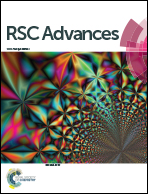Novel Zn(ii)-thiazolone-based solid fluorescent chemosensors: naked-eye detection for acid/base and toluene†
Abstract
A series of novel thiazolone-based zinc complexes, [Zn(Am4DHotaz)Cl2]·H2O (1), [Zn(Am4Motaz)Cl2] (2), and [Zn(Am4Eotaz)Cl2] (3) (Am4DHotaz = N-(4-oxothiazolidin-2-ylidene)picolinohydrazonamide, Am4Motaz = N-(3-methyl-4-oxothiazolidin-2-ylidene)picolinohydrazonamide, Am4Eotaz = N-(3-ethyl-4-oxothiazolidin-2-ylidene)picolinohydrazonamide), with intense fluorescence emission and large Stokes shifts in the solid state, have been synthesized and characterized by X-ray crystallography and various spectroscopic methods. Complexes 1–3 exhibit a similar Zn2+-coordinated pattern, but different molecular packings arising from substituent variation in the organic ligands, which finally result in individual fluorescent behaviors. All the complexes showed interesting ON/OFF/ON fluorescence switching properties induced by acid/base vapor. More interestingly, for 1, the introduction of toluene brought about a large blue shift, an obvious color change suitable for naked-eye detection, and a distinct increase of fluorescent quantum yield, which could contribute to environmental monitoring and other applications in the field of luminescent materials.


 Please wait while we load your content...
Please wait while we load your content...